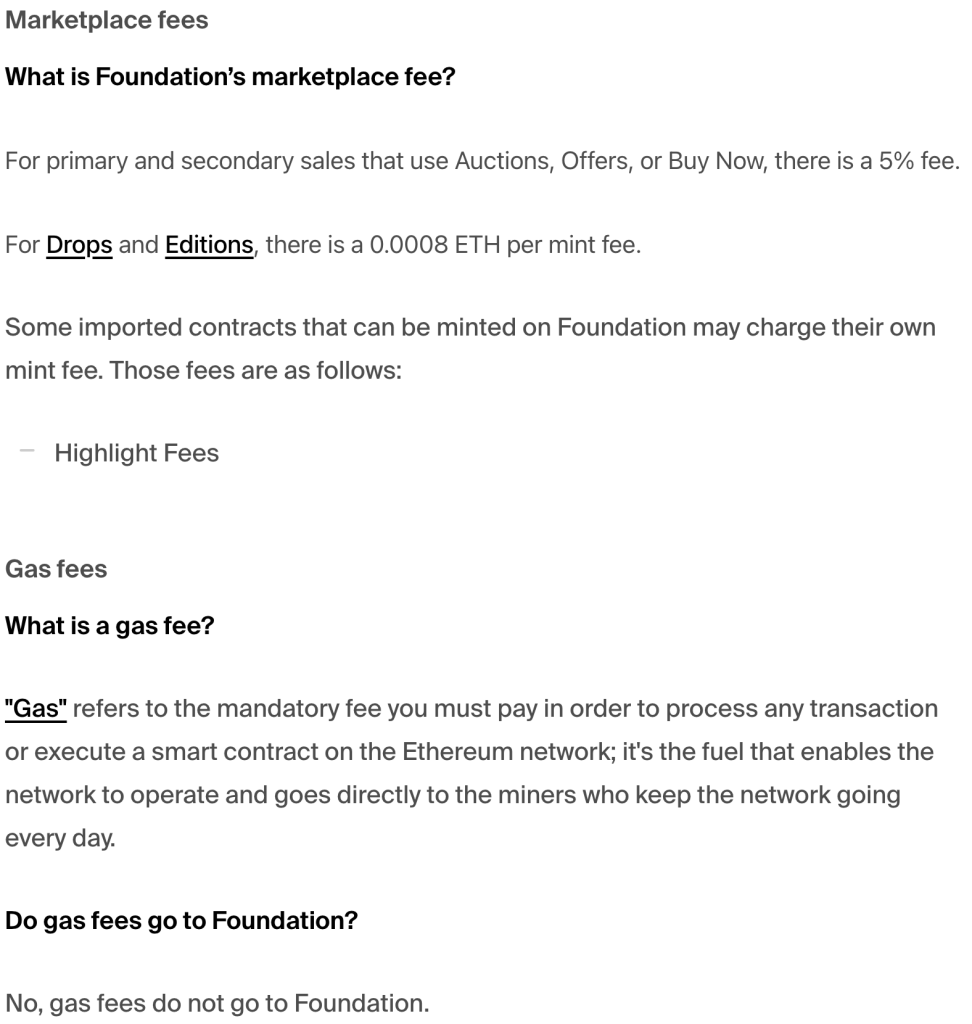
- 1. Introduction
- 2. Foundation Team & History
- 3. Key Features of Foundation NFT Marketplace
- 4. Security Aspects of Foundation
- 5. How Foundation NFT Marketplace Works
- 6. Supported Cryptocurrencies
- 7. Interface & Ease of Use
- 8. Foundation NFT Fees Review
- 9. Customer Reviews and Feedback
- 10. Customer Support
- 11. Comparing Foundation with Alternatives
- 12. Conclusion: Is Foundation NFT Right for You?
Introduction
The digital art and collectibles market has seen unprecedented growth in recent years, driven by the rise of non-fungible tokens (NFTs). Among the many platforms available for trading NFTs, Foundation has carved a niche for itself with its emphasis on high-quality, curated digital art. This Foundation NFT marketplace review will explore its history, features, security, user experience, and how it compares to other marketplaces, providing detailed insights and data to help you decide if it’s the right platform for you.
What is Foundation NFT Marketplace?
Foundation is a decentralized NFT marketplace launched in early 2021. It aims to connect digital artists and collectors through a platform that emphasizes quality and originality. Unlike other marketplaces that prioritize volume, Foundation focuses on curating a selection of high-quality NFTs, making it a popular choice for serious artists and collectors.
Why Choose Foundation?
Foundation’s commitment to curation and quality distinguishes it from other NFT marketplaces. Here are some reasons to choose Foundation:
- Curated Collections: Foundation’s team carefully selects and curates the NFTs available on the platform, ensuring that only high-quality, original works are listed.
- Artist-Centric Approach: Foundation prioritizes artists, offering them a significant share of the sale proceeds and promoting their work through various initiatives.
- Community Engagement: Foundation fosters a vibrant community of artists and collectors, providing a platform for collaboration and interaction.
- Decentralization and Transparency: Built on the Ethereum blockchain, Foundation ensures transparent and secure transactions.
Foundation Team & History
Foundation was founded by a team of entrepreneurs and developers with a background in blockchain technology and digital art. The platform quickly gained traction, attracting notable artists and collectors. Since its launch, Foundation has facilitated millions of dollars in NFT sales, with some individual pieces selling for over $100,000. The team’s ongoing commitment to innovation and user satisfaction has been a key driver of the platform’s success.
Key Features of Foundation NFT Marketplace
Foundation’s features collectively create a robust, artist-friendly platform that prioritizes quality, transparency, and community engagement. Whether you’re an artist looking for fair compensation and exposure, or a collector seeking high-quality digital art, Foundation offers a unique and valuable marketplace experience:
Curated Collections
Foundation stands out with its commitment to curating high-quality collections. Unlike many other NFT marketplaces where anyone can mint and sell, Foundation employs a selective process to ensure that only original and high-quality works are listed. Here’s a detailed look at this feature:
- Selective Onboarding: Artists need to be invited by other artists or the Foundation team to list their works, ensuring that the platform maintains a high standard of quality.
- Curatorial Team: Foundation has a dedicated team of curators who review submissions and select pieces that align with the platform’s artistic vision.
- Showcasing Talent: By focusing on quality over quantity, Foundation attracts top-tier digital artists and provides them with a platform to reach serious collectors. This approach not only enhances the marketplace’s reputation but also ensures that buyers are investing in valuable and unique art pieces.
Creator Compensation
One of the most compelling features of Foundation is its commitment to fairly compensating artists. Here’s how this works in detail:
- 85% Payout: Artists receive 85% of the final sale price of their NFTs, which is significantly higher than many other platforms. This model ensures that creators are well-rewarded for their work and can sustain their creative endeavors.
- Royalties on Secondary Sales: Artists also earn a 10% royalty on secondary sales. This means that every time an NFT is resold, the original creator receives a portion of the sale price. This feature incentivizes artists to produce high-quality work and benefits them as their pieces appreciate in value.
- Transparent Transactions: All transactions are recorded on the Ethereum blockchain, providing transparency and ensuring that artists receive their due payments promptly.
Auction-Based Sales
Foundation employs an auction-based sales system, which offers several benefits:
- Transparency: Auctions provide a transparent pricing mechanism. Buyers can see the current highest bid and decide how much they are willing to pay, fostering a fair market environment.
- Competitive Pricing: The auction format often leads to competitive bidding, which can drive up the final sale price of NFTs. This is advantageous for sellers who might receive higher compensation than through fixed-price sales.
- Engagement: Auctions generate excitement and engagement among potential buyers. The time-limited nature of auctions can create a sense of urgency, encouraging more bids and interactions on the platform.
- Extended Bidding: To ensure fair competition, if a bid is placed in the last few minutes of an auction, the auction time is extended. This helps prevent sniping (last-second bids) and ensures that everyone has a fair chance to place their final bids.
Community Engagement
Foundation places a strong emphasis on fostering a vibrant and engaged community. Here’s how it achieves this:
- Artist and Collector Interaction: Foundation facilitates direct interaction between artists and collectors. This can lead to collaborations, commissions, and a deeper connection between the creators and their audience.
- Social Features: The platform includes features such as following, liking, and commenting, which enhance user interaction and engagement. These social elements help build a supportive and dynamic community.
- Events and Exhibitions: Foundation organizes virtual events and exhibitions to showcase new works and highlight emerging artists. These events are often promoted through social media and the platform itself, driving traffic and engagement.
- Community Governance: Foundation is exploring decentralized governance models, allowing community members to have a say in platform decisions. This democratizes the platform and ensures that it evolves in a way that reflects the needs and desires of its users.
Decentralization
Foundation leverages the power of blockchain technology to ensure security, transparency, and trust. Here’s a closer look at this feature:
- Blockchain Backbone: All transactions on Foundation are conducted on the Ethereum blockchain. This ensures that every sale, bid, and transfer is securely recorded and cannot be altered, providing a reliable and transparent transaction history.
- Smart Contracts: Foundation uses Ethereum smart contracts to automate and secure transactions. These contracts ensure that funds are only transferred when the conditions of the sale are met, eliminating the need for intermediaries and reducing the risk of fraud.
- Ownership Verification: Blockchain technology allows for verifiable proof of ownership. When you buy an NFT on Foundation, the transaction is recorded on the blockchain, and ownership is indisputably transferred to your wallet.
- Decentralized Storage: Some of Foundation’s NFTs use decentralized storage solutions like IPFS (InterPlanetary File System) to ensure that the digital assets are not reliant on a single server or entity. This enhances the security and longevity of the digital art pieces.
Security Aspects of Foundation
Foundation takes security seriously, implementing a range of measures to protect users’ data, assets, and overall experience on the platform. Understanding these security aspects is crucial for both artists and collectors who are investing their time, creativity, and money into NFTs.
Privacy & Security Measures
Foundation employs robust security measures to protect user data and assets. These measures include:
1. End-to-End Encryption
Foundation ensures that all communications on the platform are encrypted. End-to-end encryption means that messages and data sent between users, as well as between users and the platform, are encrypted at the source and can only be decrypted by the intended recipient. This prevents unauthorized parties from intercepting and accessing sensitive information.
2. Secure Smart Contracts
Foundation operates on the Ethereum blockchain, utilizing smart contracts to facilitate transactions. These smart contracts are self-executing with the terms of the agreement directly written into code. Here are the benefits:
- Automation: Smart contracts automatically execute transactions when conditions are met, reducing the need for intermediaries.
- Security: Since smart contracts are executed on the blockchain, they are immutable and resistant to tampering.
- Transparency: All terms and transactions are visible on the blockchain, ensuring transparency and trust between parties.
3. Regular Security Audits
To maintain the integrity of its platform, Foundation conducts regular security audits. These audits are carried out by third-party cybersecurity firms and include:
- Code Reviews: Examining the platform’s codebase for vulnerabilities.
- Penetration Testing: Simulating attacks to identify potential security weaknesses.
- Compliance Checks: Ensuring that the platform adheres to the latest security standards and regulations.
Potential Risks
Despite these measures, users should be aware of potential risks associated with using any online marketplace:
- Phishing Attacks: Users should be cautious of phishing attempts and ensure they are interacting with the official Foundation website.
- Wallet Vulnerabilities: Users should use secure wallets and enable two-factor authentication to protect their assets.
- Counterfeit NFTs: While Foundation’s curation process minimizes this risk, users should verify the authenticity of NFTs before purchasing.
How Foundation NFT Marketplace Works
Foundation NFT Marketplace provides a user-friendly platform for both artists and collectors to engage in the buying and selling of NFTs through a transparent and secure auction system. Here’s a detailed look at how the process works.
Buying and Selling NFTs
On Foundation, the process of buying and selling NFTs is streamlined to ensure transparency, security, and a competitive market for digital art:
1. Listing an NFT
- Minting the NFT: Artists start by creating their digital artwork and minting it as an NFT on the Ethereum blockchain. Minting involves turning the digital file into a unique asset on the blockchain.
- Setting a Starting Price: Once minted, the artist lists the NFT on Foundation by setting a starting price for the auction. This price is the minimum bid that can be placed on the NFT.
- Auction Launch: The NFT is then launched into an auction, where it becomes available for bidding by potential buyers.
2. Bidding Process
- Placing Bids: Buyers interested in the NFT place bids. Each new bid must be higher than the previous one, ensuring a competitive bidding process. Foundation’s platform is designed to make this process seamless, with clear indicators of the current highest bid and the minimum increment for the next bid.
- Auction Duration: The auction runs for a predetermined period, typically 24 hours. However, this period can be extended if bids are placed in the last few minutes to prevent last-minute sniping.
- Extended Bidding: To ensure fairness, if a bid is placed in the final few minutes of an auction, the auction time is extended. This allows all interested parties to place their final bids without the pressure of a sudden auction close.
3. Auction End
- Winning Bid: At the end of the auction period, the highest bid wins the NFT. The winner is notified, and the NFT is automatically transferred to their wallet upon successful payment.
- Artist Compensation: The artist receives 85% of the final sale price, directly into their connected wallet. This compensation model ensures artists are rewarded fairly for their work.
4. Transaction Completion
- Blockchain Confirmation: All transactions on Foundation are processed and recorded on the Ethereum blockchain. This ensures that the transfer of ownership is secure and transparent, with an immutable record of the sale.
- Ownership Transfer: The winning bidder’s wallet address is recorded as the new owner of the NFT, and the digital asset is transferred to their wallet.
Setting Up the Foundation Account
Setting up an account on Foundation involves the following steps:
1. Connect a Wallet
- Choose a Wallet: Users need a cryptocurrency wallet that supports Ethereum. Popular options include MetaMask, Trust Wallet, and Coinbase Wallet.
- Connect Wallet: On the Foundation website or app, users can click on “Connect Wallet” and follow the prompts to link their wallet. This connection is necessary for all transactions on the platform.
2. Profile Creation
- Create a Profile: After connecting a wallet, users are prompted to create a profile. This profile includes a display name, bio, and profile picture, allowing users to personalize their presence on the platform.
- Add Information: Artists can add information about their work, including links to their portfolio or social media profiles. Collectors can also customize their profiles to reflect their interests and collection focus.
3. Start Browsing and Bidding
- Explore NFTs: Once the wallet is connected and the profile is set up, users can start browsing available NFTs. Foundation’s platform features various categories and filters to help users find specific types of artwork or artists.
- Placing Bids: Interested buyers can place bids on NFTs directly from the listing page. The platform provides clear instructions and ensures that all bids meet the minimum increment requirements.
- Monitoring Auctions: Users can monitor ongoing auctions, receive notifications about bids and auction end times, and participate in multiple auctions simultaneously.
Using Foundation App and Website
Foundation offers a seamless user experience through its web-based platform and mobile app. Both the website and the app feature a clean, intuitive interface, making it easy for users to navigate and interact with the platform.
Supported Cryptocurrencies
Foundation primarily supports Ethereum (ETH) for transactions. Ethereum’s smart contract capabilities make it an ideal choice for NFT transactions. Users need to have *ETH* in their connected wallets to participate in auctions and pay for NFTs.
Interface & Ease of Use
Foundation’s platform is lauded for its intuitive and aesthetically pleasing design, which makes navigating and interacting with NFTs straightforward and enjoyable for both artists and collectors.
User Experience with the Foundation App and Website
The design is visually appealing and easy to navigate, ensuring that users can quickly find and interact with the NFTs they are interested in. Features include:
1. Clean and Intuitive Design
- Visually Appealing Layout: Foundation’s website and app are designed with a modern, minimalist aesthetic that highlights the artwork and makes the user interface easy to navigate. The use of clean lines, ample white space, and high-quality images ensures that the focus remains on the digital art.
- Responsive Design: Whether accessed on a desktop, tablet, or smartphone, Foundation’s platform adjusts seamlessly to provide an optimal viewing experience. This responsiveness ensures that users can comfortably browse, bid, and interact with the platform on any device.
2. Search and Filter Options
- Advanced Search Functionality: Users can search for specific artists, collections, or NFTs using keywords. The search bar is prominently placed, making it easy to find.
- Comprehensive Filters: The platform offers a variety of filters to help users narrow down their search. Filters include categories such as price range, auction end time, and type of artwork (e.g., digital painting, animation, etc.). These filters make it easier for collectors to find NFTs that match their interests and budget.
- Sorting Options: Users can sort search results by criteria such as newest listings, most bids, highest price, and ending soon. This functionality helps users prioritize their browsing based on their preferences and needs.
3. Profile Customization
- Artist Profiles: Artists can create personalized profiles where they can showcase their portfolio, biography, and links to their social media accounts or personal website. This helps build a connection with potential buyers and provides context for their work.
- Collector Profiles: Collectors can also customize their profiles to reflect their interests, collections, and personal information. This feature enhances community engagement, allowing collectors to share their passion for digital art.
- Gallery Views: Artists and collectors can present their NFTs in a gallery-style view, making it easy for visitors to browse through their collections. This organized presentation enhances the overall user experience and adds a professional touch to profiles.
4. Notifications
- Auction Activity Alerts: Users receive real-time notifications about auction activities such as new bids, outbids, and auction end times. These alerts help users stay informed and engaged with the auctions they are interested in.
- New Listings: Collectors can subscribe to notifications for new listings from their favorite artists or specific categories. This ensures they never miss an opportunity to bid on new and exciting NFTs.
- Platform Updates: Foundation keeps users informed about important platform updates, including new features, security enhancements, and community events. These notifications help users stay up-to-date with the latest developments and opportunities on the platform.
5. User-Friendly Navigation
- Dashboard: The user dashboard provides a comprehensive overview of ongoing auctions, watchlisted items, and bidding history. This central hub allows users to manage their activities efficiently.
- Intuitive Menus: The platform’s menus are logically organized, with clear labels and icons that guide users to different sections such as “Explore,” “Auctions,” “Profile,” and “Settings.” This intuitive navigation reduces the learning curve for new users.
- Interactive Elements: Interactive elements such as hover effects, clickable buttons, and modal windows enhance the usability of the platform. These features provide immediate feedback to user actions, improving the overall interactive experience.
6. Seamless Transactions
- Wallet Integration: Connecting a cryptocurrency wallet to Foundation is straightforward, with clear instructions and support for popular wallets like MetaMask. This integration ensures that users can easily manage their funds and participate in transactions.
- Transaction Confirmation: Foundation provides clear and immediate confirmation of transactions, including bids, sales, and transfers. This transparency builds trust and confidence in the platform’s functionality.
- Security Measures: The platform incorporates robust security features, including end-to-end encryption and secure smart contracts, to ensure that all transactions are safe and transparent.
Foundation NFT Fees Review
Foundation charges a fee on each NFT sale, which is typically 5% of the final auction price. This fee is used to support the platform’s operations and development. While this fee is higher than some other platforms, it reflects Foundation’s commitment to providing high-quality services and features.

Customer Reviews and Feedback
Foundation NFT marketplace reviews are generally positive. Users praise the platform’s ease of use, security features, and high-quality NFT offerings. However, some users have noted that the fees can be higher compared to other platforms, and the auction system may not always result in the best prices for sellers.
Customer Support
Foundation offers robust customer support, including:
- FAQs and Guides: Comprehensive resources to help users navigate the platform and resolve common issues.
- Support Tickets: A system for submitting and tracking support requests.
- Community Forums: A place for users to ask questions, share experiences, and get help from other users and moderators.
Comparing Foundation with Alternatives
The NFT marketplace has grown rapidly, with several platforms emerging as major players. Foundation distinguishes itself in several key areas, but it’s helpful to compare it with other prominent NFT marketplaces to understand its unique strengths and areas for improvement.
Foundation NFT Marketplace Competitors
Here’s a detailed comparison of Foundation with alternatives such as OpenSea, Rarible, SuperRare, and Nifty Gateway:
Foundation vs. OpenSea
- Foundation: Focuses on curated, high-quality digital art with an emphasis on artist empowerment and community engagement.
- OpenSea: The largest NFT marketplace, supporting a wide range of digital assets, including art, domain names, virtual worlds, and collectibles.
Key Differences
- Curation:
- Foundation: Uses a selective onboarding process, ensuring that only high-quality and original works are listed.
- OpenSea: Open to all creators, leading to a broader but less curated selection.
- Artist Compensation:
- Foundation: Artists receive 85% of the sale price and a 10% royalty on secondary sales.
- OpenSea: Artists can set their own royalty fees for secondary sales, with the platform taking a 2.5% commission on each transaction.
- User Experience:
- Foundation: Offers a visually appealing, intuitive interface with a strong focus on user engagement and community.
- OpenSea: Provides a comprehensive and feature-rich platform but can be overwhelming for new users due to its wide range of options.
- Auction System:
- Foundation: Primarily uses an auction-based sales model, promoting transparent and competitive pricing.
- OpenSea: Supports both fixed-price listings and auctions, giving sellers more flexibility.
Foundation vs. Rarible
- Foundation: Prioritizes quality and community, with a curated selection of digital art.
- Rarible: A decentralized NFT marketplace where anyone can create, buy, and sell NFTs.
Key Differences
- Curation:
- Foundation: Invites only selected artists, ensuring high-quality offerings.
- Rarible: Open to all, leading to a diverse but less curated marketplace.
- Decentralization:
- Foundation: Operates on the Ethereum blockchain with a more centralized approach to curation and community management.
- Rarible: Fully decentralized, with governance decisions made by the community through the RARI token.
- Fees and Royalties:
- Foundation: Takes a 5% commission on sales and provides a 10% royalty on secondary sales.
- Rarible: Charges a 2.5% fee to both buyers and sellers on each transaction, with flexible royalty settings for artists.
- User Experience:
- Foundation: Known for its clean and user-friendly interface.
- Rarible: Offers a robust platform with numerous features, but the interface can be less intuitive for beginners.
Foundation vs. SuperRare
- Foundation: Focuses on high-quality, curated digital art with an inclusive community approach.
- SuperRare: A highly curated platform specializing in unique, single-edition digital art pieces.
Key Differences
- Curation:
- Foundation: Invites artists through a selective process to maintain quality.
- SuperRare: Extremely selective, only allowing top-tier artists to mint and sell NFTs.
- Market Model:
- Foundation: Uses auctions for sales, ensuring competitive bidding.
- SuperRare: Employs a fixed-price model with an option for bidding, focusing on single-edition artworks.
- Artist Compensation:
- Foundation: Artists receive 85% of the initial sale and 10% on secondary sales.
- SuperRare: Artists get 85% of the sale price, with a 3% fee on all purchases, and a 10% royalty on secondary sales.
- Community Engagement:
- Foundation: Encourages interaction between artists and collectors, fostering a collaborative environment.
- SuperRare: Focuses on high-end, exclusive art pieces, appealing to serious art collectors.
Foundation vs. Nifty Gateway
- Foundation: Emphasizes curated, high-quality digital art with a community focus.
- Nifty Gateway: A user-friendly platform known for high-profile drops and partnerships with celebrities and brands.
Key Differences
- Curation:
- Foundation: Selects artists carefully to maintain quality and originality.
- Nifty Gateway: Hosts curated drops, often featuring well-known artists and brands, but also allows a wide range of creators.
- Sales Model:
- Foundation: Relies on auction-based sales.
- Nifty Gateway: Uses scheduled drops, where NFTs are released at specific times, often leading to high demand and rapid sales.
- Fiat Integration:
- Foundation: Transactions are primarily in cryptocurrency (Ethereum).
- Nifty Gateway: Allows purchases with credit cards and fiat currency, making it more accessible to a broader audience.
- User Experience:
- Foundation: Known for its clean and artist-focused interface.
- Nifty Gateway: User-friendly with a focus on mainstream adoption and ease of use.
Who Is This Marketplace For?
Foundation is ideal for:
- Artists: Who want to showcase and sell their high-quality digital art.
- Collectors: Looking for unique and original NFTs.
- Curators: Who appreciate the platform’s emphasis on curation and quality.
Conclusion: Is Foundation NFT Right for You?
Foundation is a standout choice for artists seeking a platform that values and promotes high-quality digital art and for collectors looking for unique and original NFTs. Its user-friendly interface, robust security measures, and commitment to quality make it a compelling option in the crowded NFT marketplace space.
Frequently Asked Questions
Is Foundation NFT Legit?
Yes, Foundation is a legitimate NFT marketplace known for its curated collections and secure transactions. The platform has gained a strong reputation in the digital art community.
What Are the Fees for the Foundation Marketplace?
Foundation charges a 15% fee on each NFT sale. This fee supports the platform’s operations and development.
What Happens If Foundation Goes Out of Business?
If Foundation were to go out of business, the NFTs purchased would still exist on the Ethereum blockchain. Users would retain ownership of their NFTs, which could be managed through their connected cryptocurrency wallets.
What Are The Disadvantages of Foundation?
Some potential disadvantages of Foundation include higher fees compared to other platforms and the possibility that the auction system may not always yield the best prices for sellers.
Is Foundation Better Than OpenSea?
Whether Foundation is better than OpenSea depends on the user’s needs and preferences. Foundation is known for its high-quality, curated NFTs, while OpenSea offers a broader selection and a more extensive range of features. Users should consider what aspects are most important to them when choosing a platform.
Why You Can Trust Our Review?
Our Foundation NFT marketplace review is based on extensive research and analysis of this marketplace. We have considered various factors, including the platform’s features, security measures, user experience, and customer feedback, to provide a comprehensive and unbiased review.




